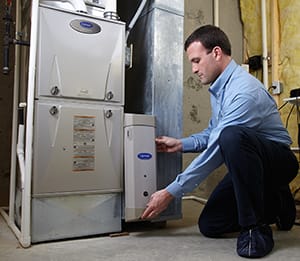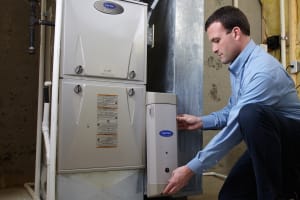How To Perform Air Filter Replacement
For the typical homeowner, changing air conditioner filters is one of the easiest air conditioner maintenance tasks you can perform. And, it’s an important facet of routine heating and cooling system maintenance because a clean filter can help keep your system running efficiently and reliably for years.

As a part of your heating and air conditioning system, the air filter plays two main roles:
- Removal of airborne particles from the air that you breathe to improve indoor air quality
- Keeping internal components free from dust and debris to maintain efficiency and reliability of operation
A dirty filter can cause a number of issues with your system. It can restrict air flow, which not only affects your comfort, but can lead to your system’s air handler working harder than normal. Over time, that can cause unnecessary wear and tear on system components. In more extreme cases a clogged filter can lead to the system turning on and off many times in rapid succession (short cycling) or even shut down completely.
To avoid these issues, be sure to inspect, clean or replace your AC filter regularly as a part of your air conditioner maintenance routine. If you do, you can help keep your system running smoothly and efficiently, and hopefully avoid an unnecessary service call from your local HVAC technician. And, once it becomes a habit, you’ll find that changing an air conditioner filter is an easy, low-cost way to maintain your comfort and hopefully save a little money down the road.
How Often To Do An Air Filter Replacement
Wondering how often to change air conditioner filters? Well, that will depend on what type of filter you have. For example, a basic, 1-inch air filter will most likely need to be replaced more often than a larger 4-inch filter. You should follow the filter manufacturer’s recommendations, but a good rule of thumb is to inspect your AC filter at least once every 2-3 months. Additional factors that can affect the timeline of how often you change your filter regularly include:
- Thermostat settings: If you tend to enjoy cooler settings in summer, your system will run more often, which may decrease time between filter changes. If you set the thermostat back to save energy, you’ll run the system less and potentially increase time between filter changes.
- Poor system installation: An undersized system will run longer and filters will likely collect more pollutants. Poorly installed ductwork may invite more airborne pollutants into the system as well. Both of these examples can potentially reduce the time between filter changes.
- Pets: If you are a pet owner, the number, size and type of animals in your home might affect timing between filter changes. Larger animals or longer-haired animals that shed more will shorten the time between filter changes.
- Quality/age of home: Older homes or poorly sealed homes tend to draw more dirt, dust and other airborne pollutants from outside. Especially in areas with air pollution issues, you will likely need to inspect and replace your filter more often.
As filter inspections become a part of your routine, you might want to purchase replacement filters in advance and have a clean filter available in case an inspection indicates it’s time for a change.

How To Change Air Filters and How To Change An AC Filter
Locate and Open Air Filter Cabinet
When it’s time to inspect your filter, always be sure to turn off power to the system. You can do this either at the thermostat, the breaker box, or using the shutoff switch located on/near the indoor unit (often looks like a light switch).
The exact location of the filter can vary depending on the indoor HVAC unit and type of system. Most single-home residential systems include either a vertical or horizontal indoor air handler unit (furnace or fan coil), typically in a basement, furnace/utility closet, garage or sometimes an attic. Look for a filter cabinet along the sides, top or bottom of the blower cabinet. The filter may be positioned horizontally or vertically, depending on the orientation of the air handler in the indoor unit. In some cases, especially on older models, the filter may be found inside the blower cabinet. If you live in a multifamily apartment or condo unit, the filter may be located in an in-wall return air grill.
Once you have ensured that power is shut off and located the filter, take a moment to determine the direction air flows through the system. Some filters will include air flow arrows to ensure proper installation. If arrows are present, take note of the direction they are pointing so you can properly re-install the old one or install the new one. Now, remove the filter from its housing and inspect it for excessive build-up of dust, dirt and debris.

Decision Time: Cleaning or Replacing Air Filters
Sometimes when you pull out the filter, it’s painfully obvious whether it’s time to clean or replace: if caked on dirt and dust are falling off the surface, it’s probably restricting air flow and you’ll want to take action. If it’s only lightly covered, or you can still see light through the filter material, you may want to clean the filter and then check again in another month. If it’s somewhere in between, you can default to the filter manufacturer’s recommendations or use your own judgment based on your own experience.
If you are replacing or changing air conditioner filters, be sure to either measure the old filter or take note of its dimensions if printed on the casing before you throw the old one away. You will need these dimensions to purchase a replacement if you don’t have a replacement filter at home already.
If you are cleaning the filter, be sure to follow the manufacturer’s recommendations. Many filters, whether disposable or re-usable can be cleaned with a vacuum cleaner nozzle attachment, being careful not to tear the filter material.
Change The Air Filter and Turn the AC Unit On
Carefully slide the new or cleaned filter back into its housing with the airflow arrows pointing in the correct direction. Properly secure the cabinet or panel cover, then restore power to the system and turn it on.
Need help with Changing Air Conditioner Filters?
Contact your local Carrier dealer for help with changing air conditioner filters or other AC maintenance tasks. Their knowledge and expertise will help ensure your HVAC system is running effectively.
- Learn How Often to Change AC Filter
- Carrier AC Filters
- See all Carrier Air Conditioners
- Find out How Do Air Conditioners Work
- Learn about Cleaning Air Conditioner Coils
- How to fix Clogged AC Drain Line
- What is a Split System?
- Find out How Do Air Conditioners Work
- Wondering "What Size Air Conditioner Do I Need?"
- Best temperature for AC - What air conditioner temperature you should set your thermostat to.
- Troubleshoot an Air Conditioner tips
- Learn what to do if you have mold in AC unit
- Discover the benefits of UV lights for air conditioners




